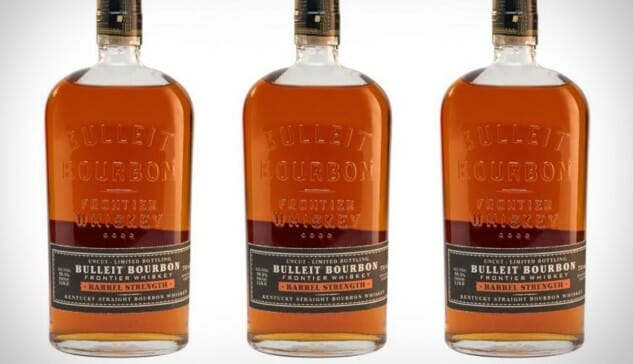Bulleit’s Bombshell: Tasting Four Whiskeys (Including Barrel-Strength Bulleit)

Members of the Paste office in Atlanta were fortunate enough to recently have a little visit from a very unique mobile bar platform—Bulleit Bourbon’s “Woody” tailgate trailer, a $150,000 rolling collection of whiskey and barcraft that parked out in front of our office for a rather delicious happy hour. It was a relaxed, fun afternoon of chatting about the ever-expanding American whiskey market and enjoying a few signature mixed drinks.
For me, though, the real sensory experience was well after the tailgate trailer rolled away. I love doing side-by-side tastings of full product lines, and this was a great opportunity to do so with the line of bourbon and rye produced by Bulleit. Since 1999, it’s the brand that Diageo has used to make massive inroads in the American brown liquor industry, achieving huge popularity along the way. The base bourbon is a bar fixture all over the country and can be dependably mixed into just about any recipe, while in more recent years Bulleit Rye and Bulleit Bourbon 10 Year have helped diversify the brand. But what really got me excited about the prospect of a side-by-side tasting was access to a small amount of Bulleit’s new Barrel-Strength Bourbon, which tips the scales at around 120 proof and is only being sold in Kentucky. How would this bruiser compare to the standard, 90-proof Bulleit?
Let’s find out.
Bulleit Bourbon
The base form of Bulleit has become one of the country’s best-known and most recognizable bourbon brands, existing in the “everyday-plus” price region—pricier and “fancier” than your Jim Beam white label or Evan Williams bottom shelf MVPs, but never breaking the bank at $25 or so per 750 ml bottle. It fills this role in the high-rye bourbon niche, as opposed to a classic bourbon mash bill such as Elijah Craig Small Batch or a wheated bourbon such as Maker’s Mark—more spicy rye than in a classic bourbon (28% of the mash), but less than in a true rye whiskey, which requires at least 51%. This makes Bulleit pretty versatile, easily swapped into mixing and cocktail situations that might also call for rye.
Tasted next to the full lineup, though, the base bourbon is unsurprisingly the least unique of the bunch. On the nose, one gets the requisite caramel and vanilla notes, and a sweetness that makes me think of toasted marshmallows. It’s corny on the palate, before a rush of spicier notes in the finish—classic, peppery spice and a bit of cinnamon. It’s a profile familiar to many bourbon drinkers who like a rye-influenced dram. At 90 proof, it’s a bit more assertive than the 80-proof rank and file that make up most of the budget bourbon rack, and also just a tad hot for its proof. It is, however, ultimately on the drier side—no one is going to taste Bulleit and mistake it for say, Maker’s Mark. Its relative dryness and spice notes are primary reasons why so many use this bourbon for mixing these days, and it fills that role admirably. It doesn’t have quite as much character as one might hope for neat drinking, but the 10 Year, on the other hand, is a very different story. More on that shortly.
Bulleit Rye
Most Bulleit whiskey is being distilled and aged at Four Roses while Diageo finishes finally getting its own Bulleit distillery open, but Bulleit Rye is instead sourced from MGP in Indiana, the same location as the juice for many other ryes such as Templeton, Redemption, etc. It comes from that same initial 95% rye stock, meaning that these ryes tend to be quite similar, although not identical. This “factory whiskey” is a big sticking issue for some drinkers, but as I’ve written in the past, it’s really not something I care about as long as I like the product—and I personally like most of the rye whiskeys coming out of MGP.
Given the differences in mash bill and the fact that it’s being produced in a different location, it makes sense that Bulleit Rye is strikingly different from the brand’s flagship bourbon. It’s a shade or two lighter in the Glencairn glass, brilliantly clear and much, much more rye-forward. The nose is a blast of spice, very peppery and also significantly fruitier, in ways the evoke stone fruit (apricot?) and candied apples. On the palate, there’s no missing that this is rye whiskey—it would be a great example to use to explain to someone the difference between bourbon and rye, honestly. It’s thinner of body and hugely spice-forward, like a multi-color peppercorn shaker with touches of cinnamon and cardamom. It’s also interestingly herbal, with notes of pine/mint and lots of fruitiness as well (green apple, peach). It’s an obvious whiskey to use for classic cocktails that call for rye (Manhattan, sazerac, Brooklyn, et al), but I personally prefer it neat over the standard Bulleit bourbon, with or without a cube of ice (probably without, if it’s me).
